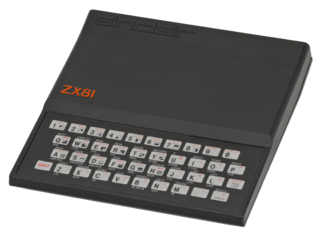
The Jupiter Ace by Jupiter Cantab was a British home computer of the early 1980s. The Ace differed from other microcomputers of the time in that its programming environment used Forth instead of the more popular BASIC.

The Sinclair ZX80 is a home computer launched on 29 January 1980 by Science of Cambridge Ltd.. It is notable for being one of the first computers available in the United Kingdom for less than a hundred pounds. It was available in kit form for £79.95, where purchasers had to assemble and solder it together, and as a ready-built version at £99.95.

The ZX Spectrum is an 8-bit home computer that was developed by Sinclair Research. It was released in the United Kingdom on 23 April 1982, and became Britain's best-selling microcomputer.

The ZX81 is a home computer that was produced by Sinclair Research and manufactured in Dundee, Scotland, by Timex Corporation. It was launched in the United Kingdom in March 1981 as the successor to Sinclair's ZX80 and designed to be a low-cost introduction to home computing for the general public. It was hugely successful; more than 1.5 million units were sold. In the United States it was initially sold as the ZX-81 under licence by Timex. Timex later produced its own versions of the ZX81: the Timex Sinclair 1000 and Timex Sinclair 1500. Unauthorized ZX81 clones were produced in several countries.

The Timex Sinclair 1000 was the first computer produced by Timex Sinclair, a joint venture between Timex Corporation and Sinclair Research. It was launched in July 1982, with a US sales price of US$99.95, making it the cheapest home computer at the time; it was advertised as "the first computer under $100". The computer was aimed at regular home users. As purchased, the T/S 1000 was fully assembled and ready to be plugged into home televisions, which served as a video monitor. The T/S 1000 was a slightly modified version of the Sinclair ZX81 with an NTSC RF modulator, for use with North American TVs, instead of PAL for European TVs. The T/S 1000 doubled the onboard RAM from 1 KB to 2 KB; further expandable by 16 KB through the cartridge port. The T/S 1000's casing had slightly more internal shielding but remained the same as Sinclair's, including the membrane keyboard. Just like the ZX81, the T/S 1000 had black-and-white graphics and no sound.
The Didaktik was a series of 8-bit home computers based on the clones of Intel 8080 and Zilog Z80 processors produced by Didaktik in Skalica, in the former Czechoslovakia.

The TK90X was a Brazilian ZX Spectrum clone made in 1985 by Microdigital Electrônica, a company from São Paulo, that had previously manufactured ZX80 and ZX81 clones.

TK82C was a Sinclair ZX81 clone made by Microdigital Eletrônica Ltda., a computer company located in Brazil.

The TK 95 microcomputer was a 1986 ZX Spectrum clone by Microdigital Eletrônica, a company located at São Paulo, Brazil. It was an evolution of the TK90X introduced the previous year.
Ringo R-470 was a Brazilian clone of the Sinclair ZX81 by Ritas do Brasil Ltda. introduced in 1983. It featured a Z80A processor at 3.25 MHz, 8K ROM and 16 KB RAM. It wasn't 100% compatible with the ZX81, and some BASIC tokens have alternate codings.

The SMC-70 is a microcomputer that was produced by Sony and released in September 1982. The system was initially released for general office use in the United States, with the SMC-70G and SMC-70GP designed for professional video generation, for example in cable television applications, and digital video effect generation. It was the first computer that used the recently invented 3.5" micro floppy disk drive that was modified to become the industry standard. Like many home and office computers of the era, it had its own specially developed version of BASIC. Sony BASIC was designed to take advantage of a color Sony Trinitron display. The SMC-70 was not sold with Microsoft BASIC, despite the system being designed to compete in the US market. With optional expansion ROMs the system could display kanji characters.
The TC 3256 or Timex Computer 3256 was a 1987 computer created by Timex of Portugal, a branch of Timex Corporation.
The ENER 1000 was a Portuguese computer released in 1982. It had 64 KB RAM and two 5+1⁄4-inch double-density floppy disk drives. It ran the CP/M operating system.
Prológica Indústria e Comércio de Mircrocomputadores, commonly shortened to Prológica, was an influential Brazilian microcomputer company that reached its peak in the mid-1980s, when it ranked third among national companies in the sector.

The NE-Z8000 is a Brazilian homebuilt computer clone of the Sinclair ZX81, introduced in late 1982 by Prológica's subsidiary, the monthly magazine Nova Eletrônica.
Tadeo Czerweny S.A. is an Argentinian manufacturer of transformers and other high-power electrical equipment founded by Tadeo Czerweny in 1958.
The TK80 was a home computer produced by Microdigital Eletrônica. A clone of the Sinclair ZX80, it was introduced along with the TK82C in 1981 during the "I Feira Internacional de Informática". There were two versions, one with 1 KB RAM costing Cr$ 68,850 and another with 2 KB costing Cr$73,650.
The NE-Z80 was a homebuilt computer kit presented by Nova Eletrônica magazine on the October 1981 issue, a publication that was part of the Brazilian Prológica group.











